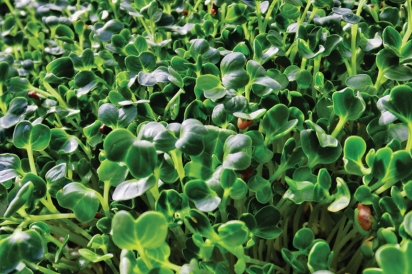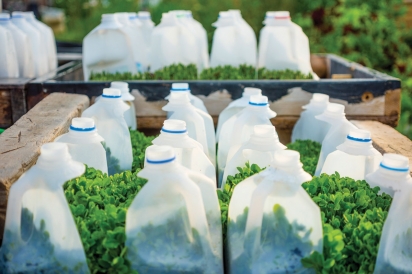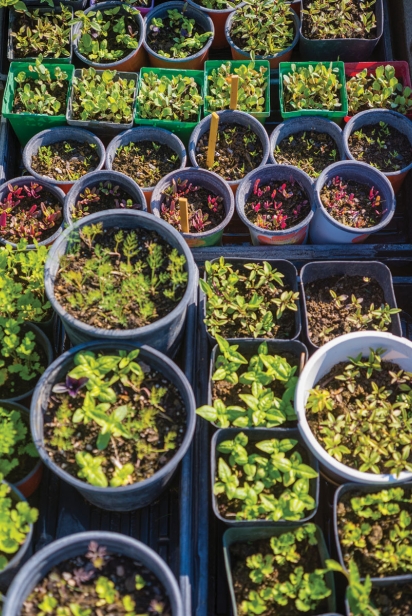Shooting for the Stars
From The Land
Microgreens are having their moment locally, thanks to a Woody Creek couple’s quest for the ideal high-altitude crop
At the end of a dusty gravel driveway in Woody Creek, the vegetable garden at Emerald Greens sprouts from the earth like secrets that can’t be kept. Astonishing, considering the land surrounding the 1,750-square-foot plot is hard-packed and dry, with no sign of the potato fields it harbored decades earlier.
It’s cliché to call it an oasis, but there’s no better descriptor. Imagine an elfin stream (in reality, an irrigation ditch) winding through the property, giving life to sweet peas, summer squash, mint, mustard greens… even ferns. This is what Martin and Kris Cooney have created in their backyard.
“We’ve lived here for 12 years and tried really hard to grow things,” Kris says. “You have to figure out how and what to grow here, because it gets really cold at night and air is always moving rapidly up the valley floor, so we had to create wind barriers.”
The Cooneys’ efforts to fine-tune their garden reveal that they are curators as much as caretakers, patrons as much as protectors. Twigs and bamboo fencing surround the plots to defy the Valley’s chilly air currents. In the heat of the day the vegetables and herbs are showered with mist; at night they’re covered and shielded from the cold. Nearly all of the greens are Lilliputian, because the Cooneys’ focus is on the micro: the first leaves on a pea shoot, the blooming flower attached to a tender fledgling zucchini, the newest leaves of mint.
On an outdoor table sit rows of milk jugs with the tops cut off, each filled with soil from which tendrils of fragile pea shoots extend. Martin cuts some and holds them up to the light. “This is a plant that has grown so fast. That leaf literally wasn’t there four or five days ago, so we’re taking the most nutritionally and flavorfully dense part at harvest.”
Microgreens—not to be confused with aforementioned nascent peas (which are harvested after they develop true leaves) or sprouts (which are germinated seeds)—are vegetable shoots harvested after the first leaves develop.
The Cooneys’ journey into cultivating microgreens didn’t start with their outdoor garden, but inside their cabin last winter. Martin was restless and Kris concerned about general health. They wanted to eat pesticide-free, homegrown and nutritious food year-round, so in the fall Martin determined to grow greens by Thanksgiving. The couple turned a spare room, which had heat, skylights and windows, into a grow space.
Recalls Martin, “We went through the catalog. We tried every seed we could. Some grew, some were finicky, some didn’t taste that good. I had too many sleepless nights wondering what I was doing wrong. But in the end, we nailed it.”
Three varieties of brassica—kale, pak choi and kohlrabi—as well as daikon radish microgreens thrived in the Cooneys’ home via hydroponics, flushed with water 24 hours a day. “They just really love our brilliant light in the winter,” says Kris. “They got an intensive amount of reflective light low in the sky, and that’s what they liked.”
Her eyes light up, describing the new greens as if they’re jewels. “The kohlrabi has this beautiful deep purple stem, and these really dark green, emerald leaves. They almost glow as the light shines through them. The kale is green on green. The pak choi has a white crisp stem and green leaf, and the radish is green, with bigger leaves.”
In the beginning, Kris gave samples to friends to obtain feedback on how long the greens lasted in the refrigerator, how they prepared them and how they tasted. “The radish is really spicy,” she notes. “You have to look at that one as an accent, but it gives the others a pop.”
It turned out the Cooneys’ microgreens endeavor (for now, business is limited to wholesale accounts) had bite, beauty and brains. They sold them to Piñons, Cache Cache and Mawa’s Kitchen last winter, but in April the plants “stopped performing the same way,” says Kris. “The end of the ski season seemed to coincide with the sudden inconsistencies in the microgreens, and we had to come to terms with the fact that they didn’t respond to the climatic changes. For us it was a product quality decision to stop growing micros until November, because we only want to offer what grows the best in the environment in which we live, because first and foremost all of the food we grow, we eat.”
As Kris and Martin walk around their edible world of ankle- and kneehigh vegetables, it’s clear their quest for the miniature has been driven by a passion that grows ever larger.
Martin stops by a mustard plant that tastes as spicy as wasabi. “Right now I’m living on flowers and greens,” he claims, picking the yellow tops off the plant and popping them in his mouth. “I’m getting the power of the microgreen. When a seed germinates some magic happens. I’ve never felt better in my life, had so much energy or been more optimistic. It’s just really been revolutionary.”









